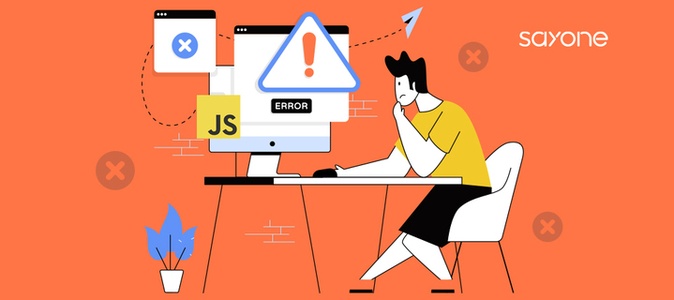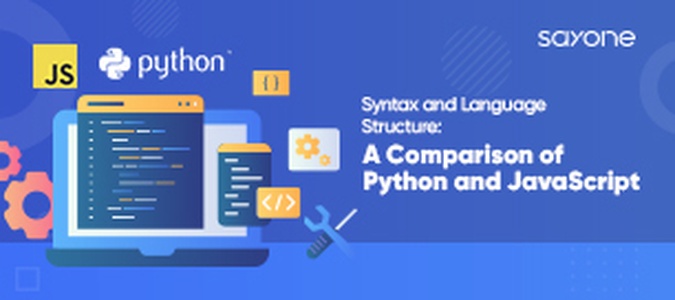JavaScript Errors: Top 6 Culprits & How to Fix Them

Share This Article
Syntax and Language Structure: A Comparison of Python and JavaScript
Table of Contents
Subscribe to Our Blog
We're committed to your privacy. SayOne uses the information you provide to us to contact you about our relevant content, products, and services. check out our privacy policy.
JavaScript is a powerful programming language widely used for web development but is not immune to errors. Understanding and resolving JavaScript errors is crucial for maintaining functional and bug-free applications. In this blog, we'll explore the top 6 culprits of JavaScript errors and provide practical solutions to fix them, ensuring smooth and reliable JavaScript code execution.
Different Types of Errors in JavaScript
- Syntax Errors
- Undefined Variables
- Null Pointer Errors
- Type Errors
- Scope Issues
- Asynchronous Errors
Syntax Errors
JavaScript syntax errors are among the most common culprits of bugs in code. These errors occur when the code violates the rules and structure of the JavaScript language. Spotting and rectifying syntax errors is crucial for maintaining error-free JavaScript applications.
One way to identify syntax errors is through error messages provided by the JavaScript interpreter or browser console. These error messages often pinpoint the exact location of the error, making it easier to fix. Let's consider an example:
Before Fix:
In this case, missing parentheses after the function name cause a syntax error. The corrected code should be:
After Fix:
How to Prevent Javascript Syntax Errors?
To prevent JavaScript syntax errors, paying attention to proper syntax and structure while writing code is essential. Here are some tips to follow:
- Double-check parentheses, braces, and brackets to ensure they are appropriately opened and closed.
- Pay attention to commas and semicolons to make sure punctuation marks are present.
- Use proper naming conventions for variables, functions, and objects.
- Utilize code editors with built-in syntax highlighting and linting features to catch syntax errors in real time.
- Test your code frequently to catch and resolve syntax errors early in the development process.
Remember, understanding and resolving syntax errors is fundamental to writing reliable and functional JavaScript applications. By diligently reviewing your code and utilizing error messages as a guide, you can catch and fix syntax errors efficiently, ensuring the smooth execution of your JavaScript programs.
Undefined Variable Error
Undefined variables are a common source of JavaScript errors. These errors occur when a variable is accessed or used without being properly declared or initialized. Understanding how to manage and handle undefined variables is crucial for maintaining robust and error-free JavaScript code.
One way to identify undefined variable errors is through error messages generated by the JavaScript interpreter or browser console. These messages often indicate the line number where the error occurred, aiding in the troubleshooting process. Let's consider an example:
Before Fix:
In this case, the variable message is not defined before its usage, resulting in an undefined variable error. To fix this error, we need to declare and initialize the variable:
After Fix:
How to Prevent Javascript Undefined Variable Errors?
To prevent undefined variable errors in JavaScript, consider the following tips:
- Always declare variables using var, let, or const before using them.
- Ensure variables are properly initialized with a value before accessing them.
- Use meaningful variable names to avoid accidental naming conflicts.
- Enable strict mode in JavaScript to catch undeclared variables during development.
- Utilize code editors or linting tools that provide warnings or errors for undeclared variables.
By following these preventive measures and being diligent about the variable declaration and initialization, you can minimize the occurrence of undefined variable errors in your JavaScript code.
Remember, managing and handling undefined variables is crucial for writing robust and error-free JavaScript applications. By carefully reviewing your code and addressing undefined variables promptly, you can ensure the reliability and stability of your JavaScript programs.
Read our blog: Checkout Python Vs Javascript: What are the Differences? in 2023
Null Pointer Errors
Null pointer errors, also known as "TypeError: null" or "TypeError: undefined," are common JavaScript errors that occur when a variable or object is accessed without a valid value assigned to it. These errors can lead to unexpected crashes and undesired behavior in your JavaScript code. Understanding how to handle null pointer errors is crucial for writing robust and error-free JavaScript applications.
Let's consider an example to illustrate a null pointer error:
Before Fix:
In this code snippet, the variable "name" is assigned a null value. When attempting to access the "length" property, a null pointer error occurs because null does not have a "length" property. The corrected code should be:
After Fix:
How to Prevent Javascript Null Pointer Errors?
To prevent JavaScript null pointer errors, consider the following best practices:
- Always initialize variables with default values to avoid null or undefined values.
- Perform null checks before accessing the properties or methods of an object.
- Utilize defensive programming techniques such as conditional statements and error-handling mechanisms.
- Use strict equality (===) or nullish coalescing (??) operators to check for null or undefined values.
- Leverage JavaScript frameworks or libraries that provide utilities to handle null pointer errors, such as optional chaining (?.) or the Nullish Coalescing Operator (??).
Implementing these preventive measures can significantly reduce null pointer errors in your JavaScript code and ensure smoother program execution.
Remember: Handling null and undefined values is essential for maintaining the stability and reliability of your JavaScript applications. By employing defensive programming practices and incorporating null checks, you can effectively address null pointer errors and create more resilient code.
Type Error
Type errors in JavaScript occur when operations are performed on incompatible data types. These errors can lead to unexpected behavior and hinder the smooth execution of your code. Understanding how to handle and prevent type errors is crucial for writing robust JavaScript applications.
One way to encounter a type error is when attempting to perform operations between different data types. Consider the following example:
Before Fix:
In this case, the code tries to concatenate a string and a number, resulting in a type error. To fix it, we can convert the string to a number explicitly:
After Fix:
How to Prevent Javascript Type Errors?
To prevent JavaScript Type errors, follow these best practices:
- Always declare variables with the appropriate data type and be consistent with their usage.
- Use type-checking methods like ‘typeof’ or ‘instanceof’ to validate data types before performing operations.
- Be cautious with type conversion functions, such as parseInt() or parseFloat(), and use them explicitly when needed.
- Pay attention to data types when working with external data sources or APIs.
By implementing these preventive measures and being mindful of data types, you can minimize type errors in your JavaScript code and ensure smooth and predictable program execution.
Remember: Handling type errors is essential to ensure the integrity and reliability of your JavaScript applications. By understanding how to identify and resolve type errors, you can write more robust code and enhance the overall quality of your projects.
Read our blog: Checkout Top 6 AngularJS Best Practices and Tips
Scope Issues
Scope issues in JavaScript can lead to confusing and hard-to-debug errors. Understanding and managing variable scope is crucial for writing clean and error-free code. Scope refers to the accessibility and visibility of variables, and when not handled properly, it can result in unintended consequences and errors.
Let's consider an example that highlights a common scope issue:
Before Fix:
In this case, the variable name is declared inside the printName function, making it inaccessible outside of that function's scope. As a result, the greet function encounters a scope issue when attempting to access the name.
After Fix:

How to Prevent Javascript Scope Issues?
To prevent scope issues in JavaScript, follow these best practices:
- Always declare variables using var, let, or const within the appropriate scope.
- Avoid using global variables whenever possible to prevent unintended scope issues.
- Use function parameters or return values to pass data between scopes.
- Use block-level scope (let and const) to limit variable accessibility within specific code blocks.
- Be mindful of function and block nesting to maintain clear and well-defined scopes.
By adhering to these guidelines, you can minimize scope-related errors and ensure that variables are accessed and modified within their intended scopes, leading to more predictable and maintainable code.
Read our blog: Outsource Java Spring Boot Services To India
Remember: Understanding and resolving scope issues is fundamental to writing robust JavaScript applications. By fixing scope-related errors and following best practices, you can enhance code clarity and avoid potential bugs caused by variable accessibility.
Asynchronous Errors
Asynchronous programming in JavaScript allows for executing non-blocking operations, enhancing the performance and responsiveness of applications. However, it can also introduce its fair share of errors and challenges. Asynchronous errors occur when the timing or handling of asynchronous operations is not properly managed. Understanding and resolving these errors is crucial for maintaining the reliability and stability of your JavaScript code.
One common type of asynchronous error is the "callback hell," where nested callbacks become convoluted and difficult to manage. Another issue is timing-related errors, where the sequence of asynchronous operations leads to unexpected results. Let's consider an example:
Before Fix:
In this case, the code outputs "World" before "Hello" due to the asynchronous nature of the setTimeout function. The corrected code, utilizing a callback function, would be:
After Fix:

How to Prevent Javascript Asynchronous Errors?
To prevent JavaScript asynchronous errors, follow these best practices:
- Utilize promises or async/await to handle asynchronous operations in a more structured and readable manner.
- Avoid excessive nesting of callbacks and use functions like ‘Promise.all’ or ‘async/await’ to manage parallel or sequential execution of asynchronous tasks.
- Handle errors properly within your asynchronous code by utilizing try/catch blocks or attaching a .catch() method to promises.
- Use appropriate debouncing or throttling techniques when dealing with events that trigger asynchronous operations repeatedly.
By adhering to these preventive measures and employing robust error-handling techniques, you can effectively prevent and resolve asynchronous errors in your JavaScript applications, ensuring smooth and reliable execution.
Remember: Mastering asynchronous programming and managing timing and callbacks are vital for writing high-quality JavaScript code. By implementing best practices and employing the appropriate techniques, you
Conclusion
Understanding and addressing the top culprits of JavaScript errors is essential for writing reliable and functional code. Developers can proactively prevent and resolve these issues by being aware of syntax errors, undefined variables, null pointers, type errors, scope issues, asynchronous errors, and DOM manipulation errors.
Developers can build robust JavaScript applications that minimize errors and deliver a seamless user experience through effective debugging techniques, proper error handling, and adhering to best practices.
If you are looking to hire the best javascript developer for your web or mobile app development services? Get in touch with us!
Share This Article
Subscribe to Our Blog
We're committed to your privacy. SayOne uses the information you provide to us to contact you about our relevant content, products, and services. check out our privacy policy.

